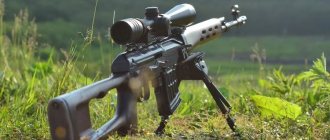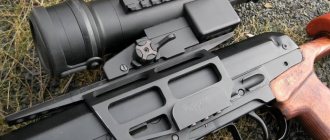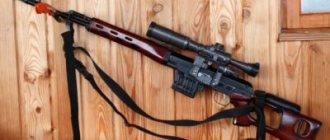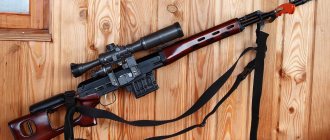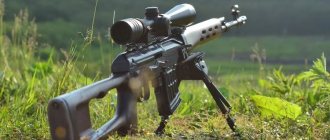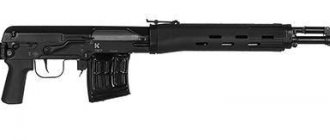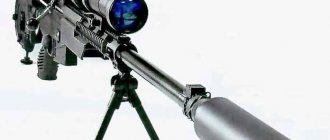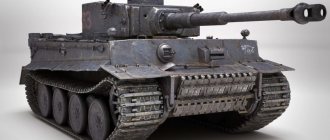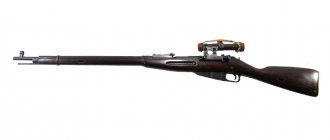The Tiger carbine is a self-loading hunting carbine, created on the basis of the Dragunov sniper rifle (SVD) and intended for hunting large and medium-sized animals. Produced in the city of Izhevsk (formerly IZHMASH). Various modifications of the Tiger carbine over the years were produced for cartridges: 7.62x54R, .308 Winchester, .30-06 Springfield and 9.3x64. Currently produced under the most popular cartridge 7.62x54R. The Tiger carbine is the most popular self-loading rifled carbine among hunters in Russia; it owes its popularity and prevalence to its unpretentiousness, simplicity of design and extreme reliability.
Story
The history of the Tiger carbine dates back to 1963, when, under the leadership of the famous firearms designer Evgeniy Dragunov, the Dragunov sniper rifle, better known under the abbreviated name SVD, was developed and put into production. The purpose of creating the SVD rifle was to create a weapon capable of replacing the sniper rifles, which were outdated by that time, based on the Mosin rifle.
In 1969, based on the SVD rifle E.F. Dragunov created the Tiger hunting carbine. The first samples were as similar as possible to the combat samples of the SVD. Until 1992, the Tiger carbine was produced in small quantities and mainly on special orders from the USSR Ministry of Defense.
Serial production of the Tiger carbine began at the Izhevsk Machine-Building Plant (Izhmash) in 1992; currently the Izhmash plant is part of Kalashnikov Concern JSC.
In 1996, the first modification of the carbine was created, which received the designation “Tiger-01”; it was designed for sale on the American market and was adapted to its requirements.
In all subsequent years, the plant launched into production new modifications of the Tiger carbine, which differ from each other in the type of stock, barrel length and other design differences. In addition to the production of the Tiger carbine chambered for 7.62x54, the plant also mastered the production of carbine chambered for .308 Win, .30-06 Sprg and 9.3x64 mm.
Brief history of creation
The Tiger hunting rifle was developed in 1963 - it completely replaced the outdated three-line model of a sniper-type rifle. The product was produced on the basis of the Dragunov sniper rifle, which in Soviet times was actively tested at shooting ranges, and then put into production at the Izhmash plant.
Since the 1970s, this model has been considered the standard of a sniper rifle and has been adopted as a standard weapon in many countries around the world.
In order not to come up with new modifications, it was decided to use the Dragunov SVD as a time-tested basis for a hunting rifle. In 1970, the Tiger 7x62x54 carbine was introduced to the hunting rifle market. It works on the same rifle cartridges, only they are equipped with semi-jacketed bullets. This carbine is used for hunting large and medium-sized animals; the advantage lies in its independence from the climatic conditions of the region.
Differences between the Tiger carbine and SVD
- The barrel length of the Tiger carbine can be 530 or 620 mm, depending on the modification, while the SVD has a barrel length of only 620 mm.
- The rifling pitch for the Tiger carbine is 320 mm, for the SVD it is 240 mm.
- The cartridge of the Tiger carbine has a control groove, which serves for ballistic identification of the weapon.
- The Tiger carbine does not have a gas regulator on the gas tube.
- The SVD sighting bar provides for shooting up to 1200 m, the Tiger carbine sighting bar is marked up to a shooting distance of up to 300 m.
- The front sight block of the Tiger carbine has a different design from the front sight block of the SVD rifle.
- The SVD has a magazine for 10 rounds, the Tiger carbine can be equipped with a magazine for 5 or 10 rounds, depending on the modification.
- The flash suppressor-compensator of the Tiger carbine is shorter than that of the SVD rifle.
- The Tiger carbine does not have a bayonet stop.
- The Tiger carbine has a changed shape of the swivel on the barrel.
Carbine KK Tiger 02 7.62x54 isp 02 pr/skl with pls lining 620mm
Carbine KK Tiger 02 7.62x54 isp 02 pr/skl with pls overlay 620mm in the World of Hunting online store
Tiger self-loading hunting carbine. 02 caliber 7.62 was created on the basis of the Dragunov SVD sniper rifle, converted into a civilian version. The Tiger carbine is produced at the site of the Kalashnikov Concern, at the Izhmash production site.
The main purpose of a rifled carbine is commercial and amateur hunting for medium and large game; the weapon is also used for tactical shooting. The operating conditions of the Tiger 02 allow you to hunt in various climatic conditions.
Reloading is carried out by using the energy of the powder gases removed from the barrel bore into the gas chamber, and the energy of the return springs.
The barrel bore of the Tiger carbine is locked onto three lugs by rotating the bolt around its axis using a longitudinally sliding bolt frame.
The trigger-type trigger trigger of a gas-operated gun ensures that a single shot is fired and the safety is engaged.
The bore and chamber of the hunting rifle are chrome plated. As a result, the service life of the semi-automatic machine is extended - the wear resistance of the material increases and corrosion is prevented.
Tiger 02 is equipped with a box magazine in a combat housing for 10 rounds. A self-loading carbine allows you to fire several shots without losing your target.
The 7.62x54 cartridge provides a high firing range and a flat trajectory.
Safety when handling a multi-shot carbine is ensured by a safety pin. Safety pin
is a flag that either prevents the trigger from moving or disconnects the trigger from the firing mechanism. Read more. Switching on and off is carried out by moving the fuse panel, either up to the “P” position, in which the trigger is locked, or down to the “O” position - fire mode.
The hunting rifle is valued by shooters for its ease of maintenance and reliable operation of its mechanisms.
Carbine Tiger 02 – compact size, maximum range.
The forend of the hunting rifle is made of impact-resistant polymer. The buttstock is made of metal in the form of a skeletal structure, folds to the side, and is equipped with a rotating cheekpiece for ease of shooting from a rest. For a comfortable grip, Tiger 02 is equipped with a pistol grip made of impact-resistant plastic.
The polyamide butt plate absorbs energy when fired, reducing recoil.
The combination of metal and polymer in black color while maintaining the basic shapes of the SVD will not go unnoticed.
The compact size of the carbine with the folded stock is an advantage for easy storage and transportation.
The Tiger carbine is equipped with standard sighting devices - a 12-bar sighting bar and a front sight. The open sight allows for effective shooting at a distance of up to 300 m.
A compact flash suppressor is installed on the barrel to reduce barrel bounce. The receiver is equipped with a side rail for installing optics.
The hunting carbine is equipped with an extended barrel 620 mm long.
Tiger isp 02 provides reliable operation - an excellent choice for a hunter.
Buy Carbine Tiger 02 7.62x54 isp 02 pr/skl with pls overlay 620mm
You can in the World of Hunting online store, or in the gun stores of our network in Moscow, St. Petersburg and other cities of Russia.
Specifications
The Tiger carbine has the following technical characteristics:
- Type:
self-loading carbine, operating on the principle of using the removal of part of the powder gases from the barrel - Caliber:
7.62x54R, 308Win (7.62x51), 30-06Sprg (7.62x63), 9.3x64 mm - Barrel length:
530 mm (chambered 7.62x54R) - 565 mm (chambered .308Win, .30-06Sprg, 9.3x64 mm)
- 620 mm (on order, chambered for 7.62x54R .308Win, .30-06Sprg, 9.3x64 mm)
detachable 5-round magazine, 10-round magazine can be installed
300 m
- 1095 mm (with a barrel length of 530 mm)
3.8-3.9 kg
The total length and weight of the Tiger carbine depend on the modification, design, type of stock, and the presence or absence of a flash suppressor.
Design of the Tiger carbine
Trunk
The Tiger carbine has a barrel length of 530 mm; there are also modifications of the carbine with a barrel length of 565 and 620 mm. The bore and chamber are chrome-plated to increase service life and simplify maintenance and cleaning. The chamber has a ballistic mark. The barrel has four grooves, two of them are 4.55 mm wide, two are 5.05 mm wide. The shape, width and profile of the rifling of the Tiger carbine differs from the shape, width and profile of the rifling of the SVD rifle; this was done at the request of the Ministry of Internal Affairs of the Russian Federation, for identification during forensic examination. These changes do not affect shooting characteristics.
The barrel of the SVD rifle and Tiger carbine is manufactured using a unique technology. The barrel blank is drilled, then reamed twice. Then the bore of the future barrel is subjected to the process of electrochemical polishing (ECP), during which the remaining roughness after deployment is melted. The barrel is then rifled using an electrochemical machining (ECM) process. A cathode with a pattern and angle of the rifling fields is inserted into the barrel bore. A current is passed through the cathode, and a special liquid is passed through the barrel bore. During the electrochemical machining process, the metal of the workpiece is washed out according to the rifling pattern. After making the rifling, the barrel blank is ground to the required external dimensions, then the barrel bore and chamber are chrome-plated.
The length of the barrel rifling can be 240 or 320 mm. Most modifications of the Tiger carbine have a rifling pitch of 320 mm; this rifling pitch allows for accurate shooting with heavy hunting bullets. The barrel of the Tiger carbine does not undergo cryogenic strengthening of the barrel and electrochemical polishing of the chrome coating, so the barrel life of the Tiger carbine is 4000 shots, unlike the SVD, which has a much longer barrel life of 10,000 shots.
At the end of the barrel of the Tiger carbine there is a thread for installing a flash suppressor. The Tiger carbine can be equipped with different types of flame arresters: short and long, conical and slotted. The flash suppressor reduces the visibility of the shot and reduces the formation of dust and gases when fired.
Shutter and automation
The Tiger carbine is a self-loading rifle that operates on the principle of using the energy of powder gases from the barrel.
The gas mechanism is located above the barrel, it is designed to remove gases from the barrel bore, and consists of a short-stroke gas piston and a gas tube.
Inside the receiver there is a bolt frame, a return spring and a trigger mechanism. The bolt frame receives the impact of powder gases from the gas piston through the pusher. When the bolt frame moves back, it cocks the firing mechanism. The bolt frame has a reloading handle. When the bolt carrier reaches the extreme point of recoil, it is acted upon by a compressed recoil spring. The force of the spring pushes the frame forward, the bolt rotates and grabs the next cartridge from the magazine, sending it into the chamber, the bolt rotates all the way, locking the barrel.
The carbine bolt has a rotating cylinder and has three lugs. The barrel bore is locked by turning the bolt cylinder to the left. Three lugs securely lock the barrel and ensure a stable bolt position.
All automatic parts of the Tiger carbine have a low mass and low energy in extreme positions, all this gives minimal deflection of the carbine when fired, quick recovery of aiming and ensures a high rate of fire of the carbine. When all the cartridges in the magazine are used up, the bolt of the carbine is locked into the bolt stop.
USM
The trigger mechanism of the Tiger carbine is assembled in a separate removable housing, ensures the firing of a shot only when the bolt is completely locked and allows only single fire. The trigger mechanism is unregulated.
The Tiger carbine has a flag-type safety, which simultaneously blocks the trigger sear and the rearward movement of the bolt frame.
Sights
The Tiger carbine has open mechanical sights consisting of a rear sight and a front sight. The front sight is non-adjustable, in a closed block, on a high bracket. There are modifications of the carbine with a height-adjustable front sight.
The rear sight is adjustable, with a distance ruler. Depending on the modification of the carbine, the notch of the distance ruler can be up to 300 or up to 1200 meters. When shooting from a Tiger carbine, do not forget that effective shooting from it with open sights with hunting cartridges is possible at a distance of up to 250-350 meters.
The receiver of the Tiger carbine has two dovetail strips for mounting optical, collimator and night sights and other additional equipment, one of the straps is located on top of the receiver and one on the side. The standard optical sights for the Tiger carbine are the PSO-1 and PO4x32 sights.
An adapter bracket with a dovetail mount and a transition to a Weaver or Picatinny rail, or quick-change brackets, is often installed on the receiver rail. Such brackets can be used to mount almost any sight on a carbine. Installation of the body kit on the receiver cover is limited by its design; it is removable; in addition, installing a bar on top of the receiver covers the open sight.
Shop
The Tiger carbine feeds cartridges from a detachable, double-stack, box magazine. The standard metal magazine for the Tiger holds 5 rounds. There are carbines equipped from the factory with a metal magazine for 10 rounds. If desired, you can find lighter magazines made of polyamide on sale, which can be of different capacities.
Butt
The Tiger carbine, depending on the modification, can be equipped with a different type of stock: folding metal, plastic or wooden.
A metal folding stock is convenient because when the stock is folded, the dimensions of the carbine are significantly reduced and it is more convenient to transport and carry.
Wooden stocks have a more aesthetic appearance, provide better balance to the carbine while aiming, and better dampen barrel vibration, thereby increasing shot accuracy. The material of the wooden stock is most often birch or beech. The wooden butt for the Tiger carbine can be of different types: in the form of an orthopedic butt with a hole for the thumb, in the form of a hunting butt with a pistol neck, in the form of a wooden laminated butt.
Plastic stocks have an aesthetic appearance and have maximum practicality compared to stocks made from other materials.
To make it easier to hold the carbine when shooting and to protect your hands from burns, the Tiger carbine has a forend, consisting of two plates, covering the gas tube and barrel. The forend pads, depending on the modification of the carbine, can be made of wood, laminated plywood or polyamide.
Tiger carbine chambered for 7.62x54R / version 02
The design of the Dragunov self-loading rifle, adopted by the Soviet Army in 1960, turned out to be so successful that it is still used in many countries around the world, and in China it has been cloned, but under a different name.
Therefore, the appearance of a series of Tiger hunting carbines - adapted to civilian SVD conditions - has become a completely natural phenomenon. They are valued for their unpretentiousness and reliability, although, like any adaptation of military weapons, they are not distinguished by extremely high shooting qualities.
A self-loading rifle that operates on the principle of using part of the powder gases from the barrel.
It is a version of the 7.62x54 caliber SVD rifle (Mosin rifle cartridge with a cartridge case with a welt on the bottom) adapted for civilian conditions. To do this, its barrel was shortened and a ballistic mark was made in it, the magazine capacity was reduced to five rounds, the bracket for attaching the bayonet was removed, and a flash suppressor was installed.
Varieties
- The Tiger carbine was produced on special orders from the early 90s until 1996. The least modified version of the SVD. The conversion consisted of shortening the barrel and installing a magazine with a capacity of five rounds. The flash suppressor is short and imperfect. The rail for mounting the optics was designed to accommodate the installation of the PSO-1 military sight. The first models were equipped with a wooden orthopedic butt without a butt plate and plastic linings on the forend. Subsequently, they began to install a shock-absorbing butt plate, and the forend was also made of wood.
- The Tiger carbine in Spanish version 01 is a variant adapted to foreign requirements, this is IzhMash’s attempt to enter the American arms market. A rail has been added to the receiver (left) for attaching tactical attachments. The butt took the form of a shoulder rest - two metal pipes, on the top there is a rotating pillow, a polyamide butt plate with a shock-absorbing butt plate. The pistol grip is almost vertical, the forend has horizontal slots for gases to escape. These parts are also made of polyamide. The barrel received a long flash suppressor, which effectively reduces recoil. Due to the increase in the length of the stock, the trigger has been moved back, and some changes have been made to the design of the trigger mechanism.
- Carbine "Tiger" in Spanish. 02 is a model with a folding metal frame stock, which has a rotating cheek pad for the shooter. The trigger mechanism is blocked when the stock is folded.
- Carbine "Tiger" in Spanish. 03 – an attempt to adapt to the requirements of offhand shooting. The butt and stock are made of solid wood (beech, birch). The stock has a Monte Carlo cushion and a groove on the neck of the stock for easy grip.
- The Tiger carbine version 05 is practically a return to the original SVD. Optionally, it is possible to install a long (620 mm) barrel and an adjustable gas engine. The flame arrester is always installed long, cylindrical. This distinguishes it from previous models, which are equipped in the basic version with a short conical flame arrester. The stock is orthopedic, made of laminated wood.
Advantages and disadvantages
- A time-tested design, quite reliable, as it might seem at first glance, because the SVD is a hybrid of a Kalashnikov assault rifle and an SVT. In practice, there are often cases when carbines with an unregulated gas engine malfunctioned during a long hunt, accompanied by the weapon falling into water, swamp slurry or sand.
- The Dragunov self-loading rifle has never been considered a sniper rifle; it has always been a means of fire reinforcement for a motorized rifle platoon, allowing it to hit targets at distances from 600 to 1500 meters. Shortening the barrel did not add any accuracy or accuracy to the Tiger carbine. This indicator is also influenced by the fact that the width of its rifling is not the same - one pair is 0.1 mm wider than the other, which was done to identify the bullet as fired from a civilian weapon.
- The butt of the carbine is not designed for shooting offhand; it is convenient for hitting targets from a point-blank range. Professional shooters note that the pads on the butt are convenient only for creating an aiming line through the optics; they are too high for the rear sight and front sight. The rubber butt plate of the butt becomes dull in the cold, which leads to bullets flying slightly higher than the target.
- 7.62x54R cartridges were created to destroy enemy personnel; they provide a high firing range and a flat trajectory. However, their bullets have insufficient stopping power. When using conventional ammunition, if you hit the wrong place, the bullet goes right through. Retrieving wounded game is always associated with great difficulties, because adult male wild boars or elk are extremely dangerous in this case.
- In the process of adapting the weapon to foreign requirements, IzhMash designers made a spring-loaded firing pin, the tip of which is hidden in the bolt mirror. However, due to the massiveness of the bolt frame, spontaneous operation of overly sensitive primers of imported cartridges is possible when the barrel is not completely locked.
Thanks to the source of the article: https://podpricelom.com/
Sample provided:
"Waffen Boutique, hunting accessories store"
St. Petersburg, Alexandra Bloka, 5
Telephone
www.tirspb.ru vk.com/spbtir
Special thanks to: Stanislav Nikolaevich Tatarnikov
Modifications and versions of the Tiger carbine
Carbine Tiger 7.62x54R
The most popular and widespread version of the carbine. This is a fairly old cartridge, known since the days of the Mosin rifle. The weight of the bullet is, as a rule, 13-13.2 grams. Muzzle energy of the cartridge is 3600 Joules. The initial bullet speed is 780 m/s. The 7.62x54R cartridge allows you to kill an elk at a distance of up to 250 meters.
"Tiger - 308"
The Tiger-308 carbine is designed for use with the 308Win cartridge (7.62x51mm). This cartridge is a very common type of ammunition; all well-known manufacturers of rifled cartridges have this cartridge in their assortment. Bullet weight can be from 6.0 to 14.8 grams. Muzzle energy 3700 Joules, for a cartridge with a bullet of 11.7 grams, at a bullet speed of 800 m/s. The length of the carbine barrel is 565 mm, on special order 620 mm. Magazine for 10 rounds. It can be equipped with a wooden hunting stock or a folding stock of the SVDS type. The weight of the carbine is from 4 to 4.2 kg. The length of the carbine with a conventional butt is from 1095 to 1155 mm, with a folding stock 880 mm. This version of the carbine is of great interest to hunters due to its high versatility of use.
"Tiger-30-06"
The Tiger-30-06 carbine is designed for use with the .30-06 Sprg (7.62x63mm) cartridge. The length of the carbine barrel is 565 mm, on special order 620 mm. 5-round magazine. Can be equipped with a wooden hunting stock or a folding tubular stock. The weight of the carbine is 3.9 kg. The length of the carbine with a conventional butt is from 1115 to 1175 mm.
"Tiger-9"
"Tiger-9" is the most powerful version of the Tiger carbine. Carbine cartridge "Tiger-9": 9.3x64 mm. Quarabine production began in 1999. The Tiger-9 cartridge has a muzzle energy of 5800 Joules, with a bullet speed of 820 m/s. The weight of the carbine is 4 kg. The length of the carbine barrel is 565 mm, on special order 620 mm. It can be equipped with a wooden hunting stock or a folding stock of the SVD type. 5-round magazine. The Tiger-9 carbine is designed for hunting large wild boar, elk hunting, bear hunting, at a distance of up to 100-150 meters. The optical sight installed on the Tiger-9 must withstand high loads when firing.
Versions of the Tiger carbine
Over many years of production, the plant produced the Tiger carbine in various designs, differing in some design features:
- The "Tiger" carbine, version (Spanish) 01, has a bar on the left side of the receiver for mounting optics. The butt of this modification consists of two metal tubes, on the top of which there is a rotating cushion. A long flash suppressor is installed on the barrel, which more effectively dampens recoil.
- Carbine "Tiger" in Spanish. 02 – differs from other modifications by the presence of a folding metal stock, similar to the SVDS stock. When folding the stock, the trigger mechanism is blocked; this is done for safety purposes.
- Carbine "Tiger" in Spanish. 03 – a carbine of this design has a wooden butt made of beech or birch, the butt has a Monte Carlo type cushion, and there is a recess on the neck of the butt stock for a comfortable hand position when shooting.
- Carbine "Tiger" in Spanish. 04 is a non-self-loading modification of the carbine; to reload, after each shot you need to jerk the bolt handle.
- The Tiger carbine version 05 is the closest approximation to the SVD rifle. Orthopedic stock made of laminated wood. It is possible to install a barrel with a length of 620 mm, like the SVD. Long cylindrical flame arrester.
Execution modifications
Depending on the purpose for which the hunter plans to use the Tiger self-loading carbine, he can choose a modification that fully satisfies his requirements. The hunting rifle has many versions, but the four listed below are the most popular.
"Tiger 7.62"
The most popular and widespread version of the carbine, which has 6 designs. For shooting, the well-known Soviet ammunition is used, which was also used to feed the Mosin rifle. The 7.62x54R bullet weighs between 13 and 13.2 grams. This allows it to reach enormous speeds - 780 m/s and above. It will not be difficult to kill an elk with such a carbine, especially if it is at a distance of no more than 250 meters. However, the further the target is from the hunter, the less force the shot will have. So the carbine is not recommended for hunting from a distance of more than 300 meters.
"Tiger 308"
This version of the carbine was created for 308 Win (7.62x51 mm) cartridges in 1993. This ammunition is not only better adapted for hunting, but also has an increased accuracy of combat at sniper distances. Bullet weight can vary from 6.0 to 14.8 grams. Moreover, muzzle energy often exceeds 3700 J, so rifles are often equipped with compensators and flash suppressors. This version of the carbine will be most in demand among hunters, but can also find universal use in the hands of an amateur.
"Tiger 30-06"
A little-known version of the Tiger, adapted for .30-06 Spring ammunition in 1995. The rifle was produced in two versions: with a plastic butt with a rotating cheekpiece like the SVD or with a hunting butt made of wood. The barrel linings on both versions were made of the same material as the butt. Both versions could be produced in a non-self-loading version. The carbine is currently out of production, so it can only be found from its current owners in an unknown condition.
"Tiger 9"
A variety chambered for 9.3×64 cartridges. The length of the rifle barrel varies from 565 to 620 millimeters. There are two options for the butt: classic wooden and skeleton. Of course, the weight of the carbine of different versions will be different. The model is distinguished by reduced firing accuracy, but increased penetrating ability of the cartridge. Used mainly for hunting large game from medium distances. Just like the previous version, Tiger 9 has been discontinued, so it is unlikely to be found in gun stores.
Operating principle
The carbine operates on the principle of removing part of the powder gases from the barrel:
- Above the barrel there is a gas cylinder, inside of which there is a gas piston.
- Powder gases from the barrel enter the gas cylinder through the hole and push the gas piston, which acts through the rod on the bolt frame.
- The bolt moves back, the bolt cylinder rotates and its stops disengage with the barrel breech. The spent cartridge case is ejected and the firing pin is cocked.
- The bolt, under the action of the return mechanism spring, moves forward, the cartridge is fed into the chamber, the bolt cylinder rotates and locks the bolt.
To charge the rifle, follow these steps:
- Press the magazine release and remove the magazine.
- Place the cartridges in the magazine in two rows, in a checkerboard pattern.
- Insert the magazine into the hopper.
- Remove the safety catch from the rifle, pull the bolt back vigorously and release.
- Put the safety on the carabiner.
Analogs
- The SVD rifle, on the basis of which the Tiger carbine was created, is very similar to the SVT rifle. It differs from it in a more massive bolt frame and receiver with guides. The number of parts that make up the return mechanism has been reduced. Due to this, its reliability has increased.
- During the Soviet era, IzhMash produced the “Bear” self-loading hunting carbine. Its kinematic design was similar to the SVT and SVD, and the bolt and its cylinder almost completely repeated the shape of the mechanisms of the Degtyarev rifle, only they were smaller and less massive. It was also different in appearance: it did not have a massive receiver, like a Kalashnikov assault rifle; most of all, it looked like a modernized SVT rifle.
If we think about other types of Tiger, then we should name model 9. By the way, such carbines as Steyr AUG-Z, Browning BAR Zenith, Remington 750 Woodsmaster can also boast a gas engine.
Shooting from a Tiger carbine is shown in this video:
Disassembly
In order to disassemble the carbine, you need to do the following:
- Disconnect the magazine from the carbine
- Check that there is no cartridge in the chamber, to do this, move the bolt, perform a control release
- Remove the receiver cover by pressing the short lever located to the left of its buttplate
- Pull out the return spring
- Slide the bolt carrier back and remove it from the receiver
- Remove the shutter cylinder by turning it clockwise
- Pull out the safety lever
- Remove the trigger
- Remove the barrel linings by sliding the barrel lining coupling forward
- Move the gas mechanism pusher back, remove the piston from the chamber
- Remove the gas mechanism pusher assembly with the spring
- The carbine is assembled in the reverse order.
Design
Self-loading repeating carbine with a gas engine located above the barrel.
- The barrel is chrome-plated, with a ballistic mark in the chamber. Four trapezoidal rifling, one pair of which has a width of 4.55 mm, and the other 5.05, which was made for the purpose of marking the bullet. A flash suppressor is installed at the end of the barrel. In the usual version, it is short and conical in shape. Optional – cylindrical, long.
- Direct-action bolt with a rotating cylinder having three lugs. The firing pin is spring-loaded, its tip does not protrude beyond the shutter mirror.
- The trigger mechanism is unregulated, the safety is mechanical, blocking the movement of the bolt frame and the trigger sear.
- The magazine is metal, double-row, with a capacity of five rounds. The latch is located behind the hopper.
- The set of sighting devices consists of a rear sight with a distance ruler and a front sight on a high bracket. There are two rails for installing optical sights: on the receiver cover and on its left plane. The receiver itself is made by milling.
The barrel lining can be wooden or polyamide, with or without holes for gas removal. The stock is orthopedic, made of steel and plastic or laminate. There is an option made from solid wood with a Monte Carlo pillow.
Carbine Tiger in Spanish. 01 (photo)
Advantages
- The design of the Tiger carbine is old, time-tested, simple and highly reliable.
- Hunters note the good softness of the trigger of the carbine; such a trigger allows even novice hunters to shoot with good accuracy.
- The low price of the carbine, especially in comparison with foreign analogues, is still the main argument in its favor.
Flaws
- The Tiger carbine does not have very high accuracy. The self-loading principle of the rifle itself significantly reduces the accuracy of the weapon. Modern bolt action rifles are accurate to less than 1 MOA. The Tiger carbine has an accuracy of about 3 MOA, although some hunters say that with the right cartridge and shooting skills you can achieve significantly higher accuracy.
- The Tiger carbine, as already mentioned, is a civilian version of the SVD rifle, and unlike the SVD it has a shorter barrel and different widths of rifling pairs. All these changes worsened the accuracy and accuracy of the Tiger compared to the SVD.
- The fairly large weight of the carbine practically does not allow it to be used for running hunting.
- Limited number of calibers in which the carbine is produced. Calibers 7.62x54R, 308Win and 9x64 are designed for hunting large game and are not suitable for other hunts.
- The main caliber for the Tiger is 7.62x54R; this cartridge was created for military purposes and was not originally intended for hunting. This cartridge does not have sufficient stopping power to reliably defeat a large animal; if it hits the wrong place, wounded animals are possible, and when hunting a large animal this can be extremely dangerous.
- The automatic operation of the carbine, although it is simple and highly reliable, can malfunction if it is not properly maintained, especially during long-term hunting, or if the carbine is dropped into water or sand.
- The weak point of the carbine is the polyamide lining of the fore-end, which squeaks and makes your hands cold in the cold. Many hunters replace them with wooden ones.
- The cartridges in the magazine of the Tiger carbine can rattle when walking and thereby unmask the hunter; it is also often changed.
- The carbine safety makes a strong click when switching; when hunting from a tower or storage shed, the sound of the safety switch can frighten the animal.
- Hunters have an ambiguous opinion regarding the orthopedic butt of the carbine. Many hunters find it inconvenient; a regular hunting stock is better suited to the requirements.
Hunting with a Tiger rifle
The Tiger carbine has a fairly large mass, so its main purpose is hunting from ambush or storage sheds. It is not suitable for walking hunting.
The caliber of the carbine determines its main purpose: hunting large ungulates and predators.
Before hunting, you must shoot the carbine, selecting suitable cartridges for it. Typically, for hunting with a Tiger carbine, cartridges with semi-jacketed bullets are used. For zeroing, paper targets measuring 75x75 cm are used. The zeroing distance is determined depending on the conditions of the future hunt, usually 100, 150 or 200 meters.
A well-aimed Tiger carbine should ensure that it hits a circle with a diameter of 10 cm when shooting with an optical sight, and a circle with a diameter of 20 cm when shooting with open sights. These results will be quite sufficient for most hunts.
To understand whether the Tiger carbine is right for you, you need to have a good idea of why you are purchasing a rifled weapon, who you are going to hunt, in what way and under what conditions.
The Tiger carbine is well suited for driven hunting, for example when hunting wild boar or elk, when you often have to fire not one, but two or three shots in a row.
When hunting from a tower or storage shed, only one shot is needed; a bolt-action rifle is better suited for such hunting.
Tuning the Tiger carbine
The Tiger carbine provides its owners with great opportunities for tuning. On sale you can find a large number of spare parts and various tuning elements for the Tiger. Most often, owners improve their carbine with the following tuning elements:
- An open mechanical sight is not suitable for accurate shooting at long distances, so many owners install an optical or night sight on their rifle. With this improvement, the firing range and accuracy significantly increases.
- Many owners of the Tiger carbine change the stock on it, since the original stock does not suit them in terms of height or other anthropometric data, or does not suit them for some other reason. Buttstocks for SVD rifles and Tiger carbines are produced by many domestic and foreign manufacturers.
- The original receiver linings are replaced with others that have a Picatinny rail or a Keymod interface. After such an upgrade, it will be possible to install additional equipment on the carbine: a flashlight, a bipod or a laser target designator.
- The effectiveness of the Tiger carbine can be seriously increased by installing a bipod on it. Bipods help well with target shooting, when hunting from a storage shed or a blind.
- A more effective flame arrester is placed on the barrel of the Tiger carbine, either from an SVD, or an externally simulating silencer. We should not forget that the manufacture and installation of a silencer on a Tiger carbine is illegal.
- Some owners replace the standard bolt handle with a more modern and ergonomic rubberized one.
- Many people put a shock-absorbing pad made of frost-resistant rubber on the butt of the carbine to soften the recoil.
Options and packaging
- The carbine is supplied in a cardboard box. Additionally packaged in a sealed plastic bag.
- The usual delivery set includes a magazine, cleaning tools (a brush and a wiper in a metal case), as well as spare parts for the trigger mechanism - a bushing and a firing pin spring.
- The extended package contains an optical sight with a bracket, an oiler, and a cleaning rod.
- Attached is a technical data sheet and an instruction manual.
Improvements to the Tiger rifle are discussed in the video below:
